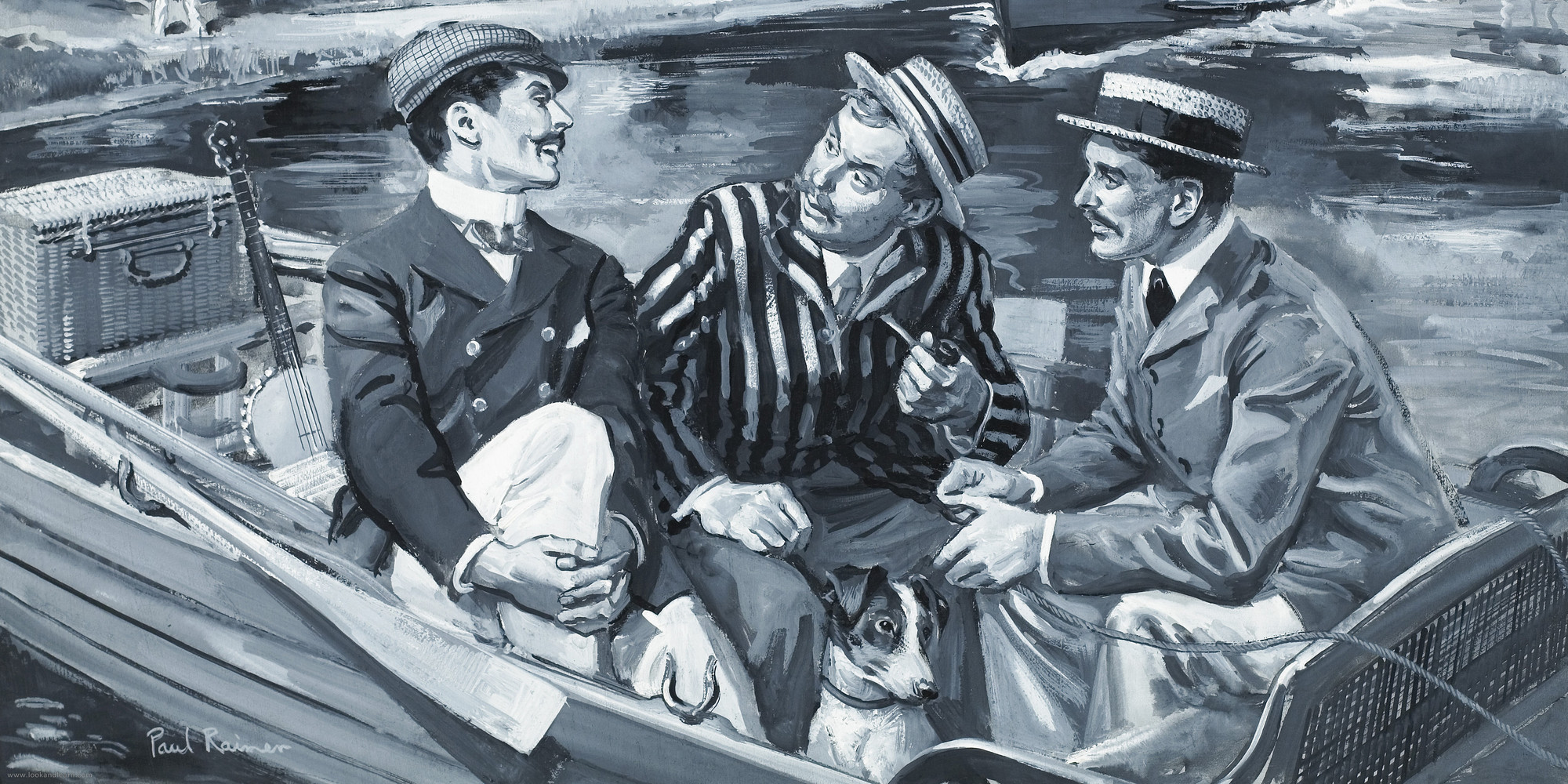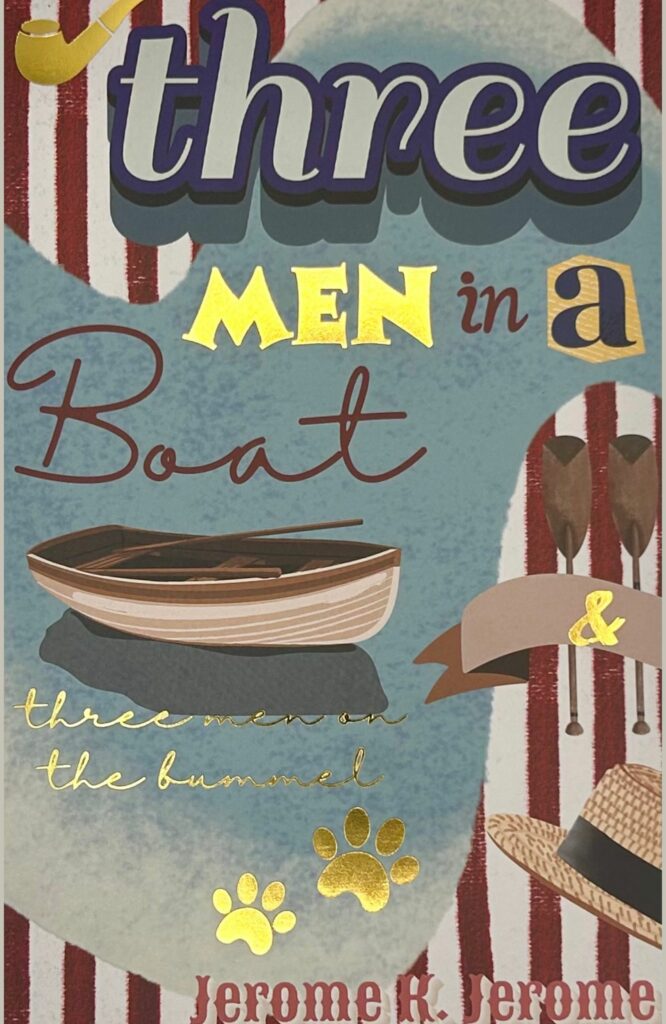
David Stuart Davies looks at Three Men In A Boat
David Stuart Davies looks at Jerome K. Jerome’s classic comic tale, ‘Three Men in a Boat’.
There have been numerous dramatic productions of Jerome K. Jerome’s comic novel, Three Men in a Boat on stage screen and radio. Many have been successful and satisfying but none, I believe, have quite captured the full power and humorous spirit of the novel because the true joy and subtle comedy of the narrative is in the way the story is presented on the page. It is the writing, the arrangement of the words and the clever recital of the amusing anecdotal scenarios, which make this book unique and a classic.
The premise of the novel is a simple one: three men decide to take a trip down the River Thames for a holiday, believing that a short time communing with nature in the amiable company will add a reviving glow to their tired lives as they all believe they are suffering from ‘overwork.’ The narrative records a series of incidents and mishaps that occur as they journey down the river. In essence, the trip is a typical boating holiday of the time in a Thames camping skiff. These pleasure jaunts became popular and fashionable just after commercial boat traffic on the Upper Thames had died out.
The three men are based on Jerome himself who acts as the narrator J., and his two real-life friends, George Wingrave, who became a senior manager at Barclays Bank and Carl Hentschel, called Harris in the book. A great deal of the humour derives from the interaction of their diverse personalities. Jerome reveals that when thrown together in close proximity for a certain length of time even very good friends can get on each other’s nerves and reveal idiosyncrasies that had not been observed before. Martyrs to hypochondria and general seediness, J. and his friends could hardly have envisaged the troubles that lay ahead of them on their river trip with tow-ropes, unreliable weather forecasts and those impenetrable tins of pineapple chunks – not to mention the devastation left in the wake of J.’s small fox-terrier Montmorency. However, ultimately, Three Men in a Boat is a study of friendship, human foibles and forgiveness. The three men are closer in friendship than ever by the time they reach the end of their journey.
Interestingly, Three Men in a Boat began life as a travel commission for the magazine Home Chimes. Its author later described how the focus and the nature of the volume changed: ‘I did not know I was a humorist,’ he admitted. ‘The book was to have been ‘The Story of the Thames’, its scenery and history… I never got there. It seemed to be all ‘humorous relief’. By grim determination, I succeeded, before the end, in writing a dozen or so slabs of history and working them in, one to each chapter, and F.W. Robinson, who was publishing the book serially, promptly slung them out.’
When the book was first published in 1889 it was reviled by the critics for its lowbrow language and its triumvirate of hopeless, neurotic protagonists, but Three Men in a Boat was an instant success with the public and, with its benign escapism, authorial discursions and a wonderful evocation of the late Victorian ‘clerking classes’, it hilariously captured the spirit of its age. However, the book has a timeless appeal and, as in the very best picaresque tales, the trip down the river to Oxford is little more than a convenient peg on which to hang a series of observations and authorial asides about life, in all its minute, baffling and absurd complexities. Jerome wrings the most improbable humour from the most mundane situations. For example, the digression about his Uncle Podger’s efforts to hang a picture is so delicately crafted that it has all the glorious hilarity of cinematic slapstick. And any book that includes a discussion on ‘the advantages of cheese as a travelling companion’ is bound to raise a laugh.
The immediate success of the novel prompted a female take on the scenario in 1891 when Three Women in One Boat: A River Sketch by Constance MacEwen was published. This book relates the journey of three young university women who set out to emulate the river trip in Three Men in a Boat in an effort to raise the spirits of one of them, who is about to be expelled from the university. To take the place of Montmorency, they bring a cat called Tintoretto.
The first movie version of Jerome’s novel appeared in 1926, followed by two others in 1933 and 1956. The latter starred David Tomlinson as J., Jimmy Edwards as Harris and Laurence Harvey as George. In 1981 A one-man show adaptation earned Jeremy Nicholas a Best Newcomer in a Play nomination at the 1981 Laurence Olivier Awards. In 2005 the comedian Griff Rhys Jones, Dara Ó Briain, and Rory McGrath embarked on a recreation of the novel for a BBC TV series, Three Men in a Boat. There has even been a musical version filmed for Soviet television in 1979. The book has also made its way into the world of art. A sculpture of a stylised boat was created in 1999 to commemorate Three Men in a Boat on the Millennium Green in New Southgate, London, where the author lived as a child. In 2012 a mosaic of a dog’s head was created on the same Green to commemorate Montmorency.
In 1898, Jerome produced a sequel Three Men on the Bummel, inspired by a short stay in Germany. The book involved the same characters in the setting of a foreign bicycle tour but it failed to capture the freshness and simple humour of the original, which remains a supremely satisfying, engaging and funny read. It is no wonder that Three Men in a Boat has never been out of print. The Guardian ranked it as number 25 of The 100 Greatest Novels of All Time in 2015 – and Esquire placed is at number 2 in the 50 Funniest Books Ever in 2009.
Books associated with this article
